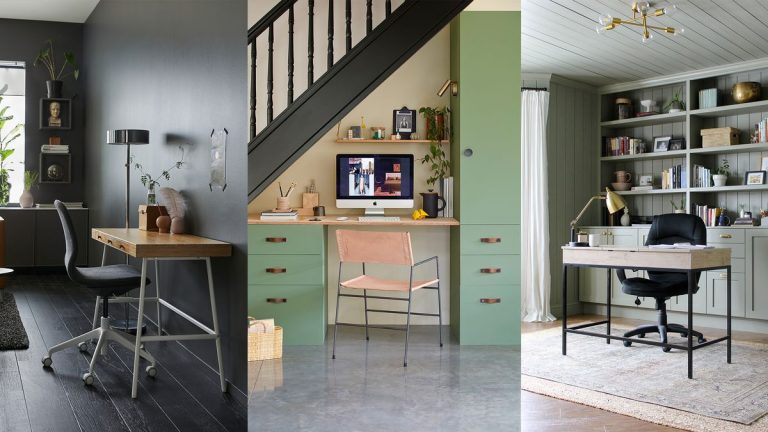With more people than ever working from home, IKEA home office ideas are becoming increasingly popular among people looking for functional, stylish and affordable furniture solutions for 21st century living.
Whether you have a dedicated room for work or want to integrate a workstation into a multifunctional living space, IKEA offers a range of flexible home office solutions, from prefabricated modular shelving and cabinet systems that can be configured into endless layouts, to portable, freestanding products.
To get you inspired, we've rounded up a bunch of home office ideas that incorporate IKEA products and clever uses of IKEA furniture. Plus, IKEA designers offer tips and share their favourite IKEA room ideas.
IKEA home office ideas
From ergonomic desks and chairs to office lighting, there are plenty of ways to incorporate IKEA home office ideas into your office layout.
Home office storage is one of the most important things to consider when designing a new workroom. From open bookcases and closed cabinet systems to storage desks, filing cabinets and desktop organizers, IKEA has a storage solution for every scenario. “Organized storage helps create a calm, uncluttered permanent workspace,” says Karen Haas, IKEA's US workspace business leader. “Keep the things you use often, like papers and pens, within reach. Items you use less often can be stored further away.”
But with many of us lacking the luxury of a separate home office and our workspace often being incorporated into the living room, dining room or bedroom, maintaining a work-life balance requires some clever thinking.
“What's needed are workspace solutions that can blend in with a wide range of furniture and décor, and conceal work areas when not in use,” says Karen Haas. “For example, use enclosed storage for on/off solutions to hide work items when not needed, and use movable furniture with storage capabilities to support workspaces shared by individuals, partners or families.”
1. Choose the right desk
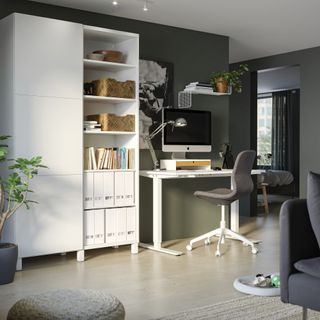
(Image courtesy of IKEA)
An ergonomic office desk and adjustable chair are essential for any home office, and IKEA has a wide range of products, from traditional-style desks with side drawers to sleek, contemporary Scandinavian designs.
Sitting for long periods of time can affect your health, so consider an adjustable sit-or-stand desk, similar to TROTTEN's design, says Karen Haas, Ikea's business leader for U.S. workspace. “Varying your posture throughout the day can make a big difference. Alternating between sitting and standing improves circulation and helps reduce the harmful effects of sitting for long periods of time.”
“To maintain a healthy posture, place your screen at eye level. Your monitor should be tilted at 20 to 30 degrees – this is the optimal angle for your eyes as well as your neck and shoulders,” adds Karen Haas.
To achieve the optimal working posture, consider adding an ELLOVEN monitor from IKEA. “It positions your monitor at the right height to help relieve back and shoulder strain,” says Grant Robinson, interior design leader for IKEA UK and Ireland. “It also comes with a handy drawer and space to store your keyboard, helping to keep your workspace neat and tidy.”
2. Implement internal storage
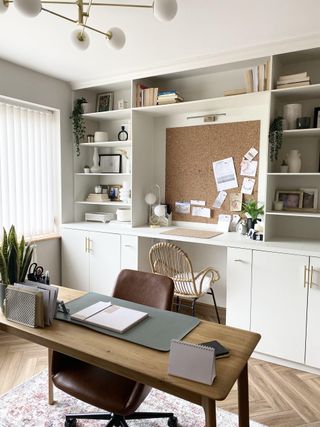
(Image credit: Kate @reno_by_the_beach)
Built-in furniture, fitted from floor to ceiling, is a great way to maximise the storage space in your home office whilst still maintaining a neat and tidy feel – however bespoke solutions can be costly. As part of a modular system, Ikea offers a range of standard sized units that can be arranged in endless ways to create the perfect layout to suit your architecture.
Here, Instagrammer Kate White of @reno_by_the_beach opted to combine open shelves with closed cabinets, providing plenty of storage space to hide printers and files, while still leaving room for aesthetically pleasing items.
“When designing the office, we wanted a functional workspace with décor that was aesthetically pleasing and matched the neutral theme of the home. To keep the budget in check, we used IKEA furniture to try to recreate the look of more expensive built-ins. To achieve this, we used Metod base cabinet frames, Metod base cabinet pull-outs, LAGKAPTEN tabletops and BILLY bookcases,” explains Kate.
“We finished the look with baseboards and coving before priming with Zinservin and painting with Rust-Oleum Steamed Milk.”
3. Make the most of unused space

(Image courtesy of Future)
Our modular cabinets can be configured into any layout, making them perfect for creating a practical workspace in awkward spaces like under the stairs. Here, the METOD cabinet with green doors and drawer fronts is combined with simple wooden shelves to integrate a compact workspace into the living space.
Whether you're going for a traditional or modern look, Ikea offers a variety of door styles to suit, and there are also a number of companies that offer designer doors for Ikea cabinets for a unique look – try Reform or Semihandmade.
4. Create a cozy farmhouse atmosphere
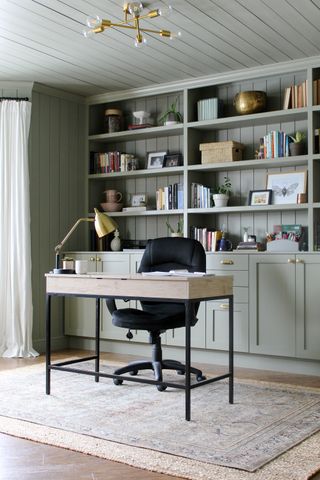
(Image courtesy of @simplifythechaos)
Many companies offer custom doors for IKEA cabinet systems, so you can really create any look you want, whether that's farmhouse decor ideas or a modern minimalist style. Sarah Weirich @simplifythechaos installed DIY Shaker doors from Semihandmade onto IKEA Sektion cabinets, finished in sage green, to create a cozy farmhouse-inspired office. Layered rugs, glossy light fixtures, and rejuvenating hardware all contribute to the warmth of the space.
5. Create a workspace in your bedroom
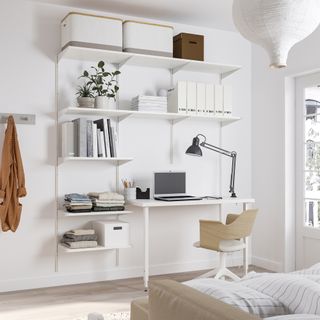
(Image courtesy of IKEA)
If you don't have a separate room for a home office, bedrooms are often used as office space, and it can also be useful to incorporate a desk into a teenager's room to provide them with a quiet place to study.
For a modern, streamlined bedroom office idea, try integrating your desk with Ikea's multifunctional BOAXEL wall organisation system. Unlike built-in storage systems, this open wall shelf can be easily adapted if the function of the space changes, and can even be used as a wardrobe system.
6. Choose freestanding pieces
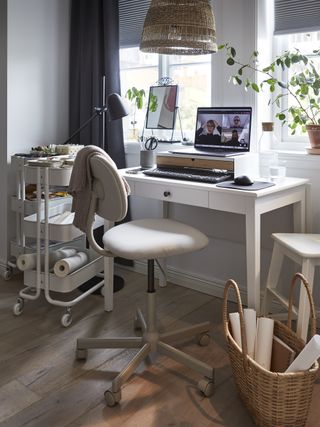
(Image courtesy of IKEA)
As well as built-in storage systems, IKEA also offers a wide range of freestanding furniture that's particularly useful if you use your home office as a multifunctional space.
Choosing freestanding office furniture, such as slim, lightweight desks or storage units on castors, such as IDÅSEN file units or RÅSHULT trolleys, can be easily moved to free up floor space for other uses – for example, to make room for a fold-out guest bed or free up floor space for online exercise classes – can also be easily moved from room to room and home to home.
7. Zone your office space
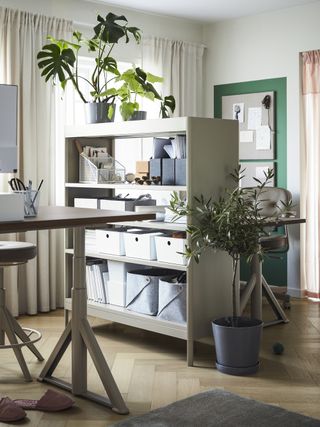
(Image courtesy of IKEA)
With open-plan living rooms often the norm, it can be difficult to find a space to incorporate a quiet workstation where you can focus and not be disturbed. Similarly, when creating a workspace in a living area, it's important to provide some sort of separation so that work doesn't intrude on family life. Freestanding shelving units such as the TROTTEN shelving unit or this IDÅSEN unit or room dividers from Ikea can help you quickly and easily zone your workspace.
8. Customize your IKEA office furniture
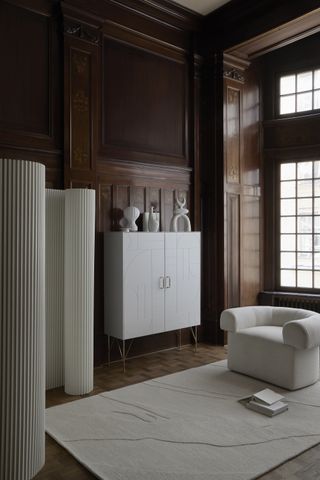
(Image courtesy of Superfront)
As well as functionality, your home office should also be stylish and inspiring – that helps keep you motivated. For an instant touch of personality, try giving a simple storage unit a designer touch to turn it into a statement piece. Here, IKEA's Bestå sideboard is fitted with Superfront's Ashton Grey geometric doors, brass Twine handles and slender high legs, creating a luxe look at a fraction of the price.
9. Create a simple and relaxing space with just a few items
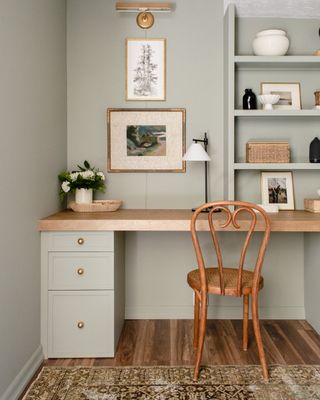
(Image courtesy of Jyll Mackie)
The great thing about IKEA home office ideas is that with a little creativity, you can completely transform your space with just a few items, as demonstrated by this IKEA hack by Instagrammer and content creator @Jyll_Mackie.
“I used ALEX drawers from IKEA but added 1/4-inch MDF trim to the drawer faces to give them a shaker look and finished them with Benjamin Moore oilcloth. I built everything in and added a chunky desktop made from cheap plywood,” she explains.
10. Don't forget the lighting
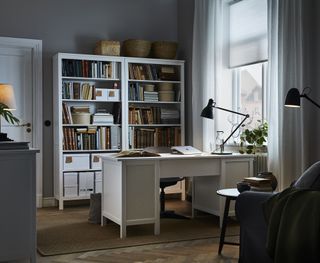
(Image courtesy of IKEA)
The lighting in your home office can have a big impact on your vision, health, and productivity, so getting the lighting right is important. Karen Haas, business leader for workspaces at IKEA US, recommends layering different lighting throughout your home office.
“Task lighting is key. Use focused task lighting to keep your work surface well-lit, but it's also important to have adequate general lighting throughout the room. Place diffused light behind your computer screen to reduce eye strain and make it easier to work. Mood lighting softens the contrast between general and task lighting.”
She also suggests, “Arrange your workspace so that sunlight comes from the side or front, rather than behind, to prevent glare on your computer screen.”
Adding window blinds or curtain ideas is a good way to control light levels and privacy in your home office and can help block out the harsh midday sun.
11. Balance function and style
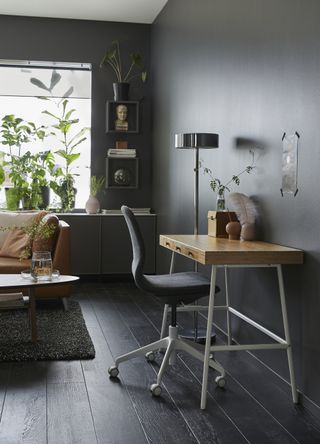
(Image courtesy of IKEA)
When thinking about a desk for your living room, consider a discreet, stylish design that fits seamlessly into your décor so the space remains relaxing and comfortable. “The LILLÅSEN desk is a sleek desk made from sturdy bamboo that looks great from all angles so you can place it in the centre of the room if you like. It has three A4-sized drawers for storing documents and other small items,” says Grant Robinson, interior design lead at IKEA UK.
How do you set up a home office in a small living room?
Setting up a home office in a small living room should limit the furniture to the bare essentials: a desk, a chair and a small storage unit. Try a lightweight, easy-to-move desk with a portable filing cabinet or storage unit underneath, so you can easily store your papers away and out of sight at the end of the day.
Alternatively, try a desk with built-in drawers or install a floating shelf desk in your living room alcove to create an office nook and make the most of the space. You could also try out the idea of a hidden slide-out desk that slides out of sight into a cabinet at the end of the day.
“Small office supplies can be stored in a desktop organizer or on a wheeled cart that can be easily carried to where you're working, allowing for more flexibility and quicker tidying up when you're done,” says Karen Haas, business leader for workspace at IKEA US.
When floor space is limited, it's important to make the most of wall space for storage. Installing built-in cabinets with closed doors can help hide printers, table fans and larger office supplies, keeping your living space calm and orderly. Open shelving is great for keeping frequently used items and books close at hand, but be careful not to make your living space look cluttered. Try adding some small storage bins to store smaller items.
Where should I put my desk in my living room?
To achieve a good work-life balance, consider placing your desk away from relaxation areas and creating a good separation between your living space and your desk.
“Consider separating your work zone with a curtain during breaks,” says Karen Haas, business leader for workspace at IKEA US. She also advises, “Hide or put away your work items during off-hours to create a visual distinction between work and personal time. Consider separating your work zone with a curtain during breaks.”
Placing your desk in front of a window not only makes the most of natural light, but the beautiful view outside can “boost your creativity and mental well-being,” adds Karen Haas.

